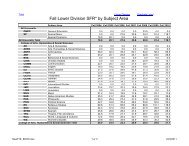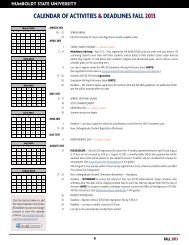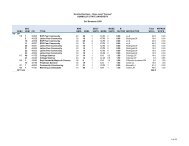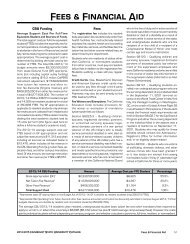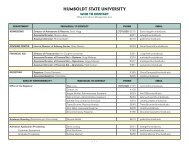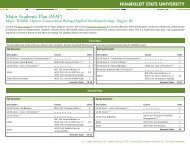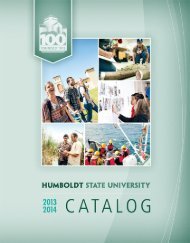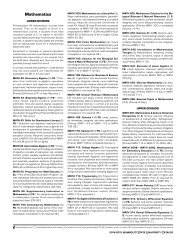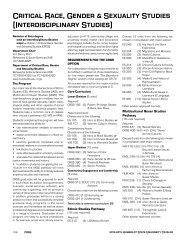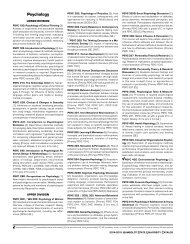2007-08 Academic Year - Humboldt State University
2007-08 Academic Year - Humboldt State University
2007-08 Academic Year - Humboldt State University
Create successful ePaper yourself
Turn your PDF publications into a flip-book with our unique Google optimized e-Paper software.
Criminal Justice<br />
Minor in Criminal Justice<br />
Coordinator<br />
Judith Little, Ph.D.<br />
Library 011<br />
Department of Sociology<br />
Library 055<br />
(707) 826-4561<br />
The Program<br />
This is an interdisciplinary program for<br />
students interested in the criminal justice<br />
system in the United <strong>State</strong>s. Students may<br />
select courses to examine specific emphases<br />
in the broad area of criminal justice such<br />
as environmental crime and justice, dynamics<br />
of criminality and substance abuse, law<br />
and the administration of justice. Students<br />
planning to work within the criminal justice<br />
system, as advocates for environmental<br />
issues, as substance abuse counselors, as<br />
counselors for troubled youth, with native<br />
peoples, or interested in pursuing a law<br />
degree should benefit from this minor.<br />
REQUIREMENTS FOR THE MINOR<br />
A minimum of 20 units from the following:<br />
Introduction (required)<br />
SOC 430 Criminology<br />
Breadth (minimum of 13 units distributed<br />
among at least 3 groupings)<br />
ANTH 339 Forensic Anthropology<br />
NAS 332 Environmental Justice<br />
NAS 360 Tribal Justice System<br />
PSYC 406 Forensic Psychology<br />
PSYC 438 Dynamics of Abnormal<br />
Behavior<br />
PSYC 473 Substance Use & Abuse<br />
PSCI 313 Politics of Criminal Justice<br />
PSCI 316 Public Administration<br />
PSCI 410 American Constitutional<br />
Law: Civil Rights & Liberties<br />
PSCI/ENVS/NRPI 412 Legal Research<br />
REC 310 Recreation for Special Groups<br />
SOC 330 Social Deviance<br />
SOC 363 Environmental Crime<br />
SW/SOC/WS 319 Ecology of Family<br />
Violence<br />
SW/SOC 431 Juvenile Delinquency<br />
SW 442 Drugs, People & Society<br />
Capstone (choose one)<br />
PSYCH 483 Community Psychology<br />
Experience<br />
PSCI 470 Internship<br />
REC 495 Directed Field Experience<br />
SOC 482 Applied Sociology<br />
• • •<br />
Crosscultural Language &<br />
<strong>Academic</strong> Development<br />
A program of study leading to a certificate<br />
issued by the California Commission<br />
on Teacher Credentialing<br />
Department of English<br />
Kathleen Doty, Ph.D., Department Chair<br />
Founders Hall 201<br />
(707) 826-5917<br />
Terry Santos, Chair<br />
Committee to Administer Programs in<br />
Teaching English as a Second Language<br />
Founders Hall 214<br />
(707) 826-5988<br />
The Program<br />
This course of study enables current and<br />
prospective holders of a California teaching<br />
credential to obtain a Crosscultural Language<br />
and <strong>Academic</strong> Development (CLAD) certificate<br />
that is issued not by <strong>Humboldt</strong> <strong>State</strong><br />
<strong>University</strong> but by the California Commission<br />
on Teacher Credentialing.<br />
A CLAD certificate authorizes teachers to<br />
provide two types of instruction to limited-<br />
English-proficient students:<br />
• English as a second language (ESL) instruction<br />
to develop listening, speaking,<br />
reading, and writing skills; and<br />
• specially designed academic instruction<br />
delivered in English. SDAIE, also known as<br />
“sheltered English,” allows K-12 students<br />
access to core subjects, such as math<br />
and social studies, as they continue to<br />
improve their English ability.<br />
This program is offered at <strong>Humboldt</strong> so<br />
that students in elementary, secondary,<br />
and special education programs may obtain<br />
a CLAD certificate when they obtain their<br />
teaching credentials. It is also open to local<br />
teachers.<br />
The larger goal—one <strong>Humboldt</strong> shares with<br />
the CCTC—is to ensure that California teachers<br />
are trained to teach in schools with linguistically<br />
and culturally diverse students.<br />
The number of K-12 students with limited<br />
English proficiency continues to grow, increasing<br />
the demand for trained teachers.<br />
This program improves both the competence<br />
and employability of current and<br />
prospective teachers.<br />
REQUIREMENTS<br />
• Complete the required course work as<br />
outlined below. Note: ENGL 326 or 328<br />
or the equivalent is a prerequisite for<br />
ENGL/COMM 417. ENGL 435 is a prerequisite<br />
for 436.<br />
ENGL 326 Language Studies for<br />
Teachers or<br />
ENGL 328 Structure of American<br />
English<br />
COMM 322 Intercultural<br />
Communication<br />
ENGL/COMM 417 Second Language<br />
Acquisition<br />
ENGL 435 Issues in English as a<br />
Second/Foreign Language<br />
ENGL 436 Integrating Language<br />
& Content in English<br />
Instruction<br />
• Possess a valid teaching credential (see<br />
Education for credential programs).<br />
• Apply to the California Commission on<br />
Teacher Credentialing for the CLAD certificate.<br />
• • •<br />
<strong>2007</strong>-20<strong>08</strong> <strong>Humboldt</strong> <strong>State</strong> <strong>University</strong> Catalog<br />
Crosscultural Language<br />
81



